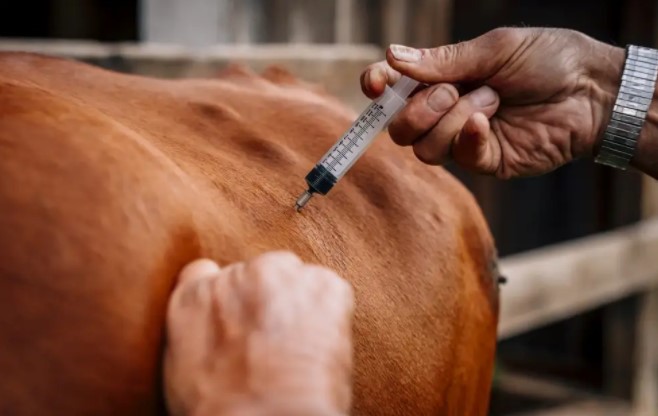
Agricultural News
OSU Extension Members Advise on OQBN Vaccination Protocols
Wed, 08 Sep 2021 16:03:47 CDT
 Weekly, Oklahoma State University Beef Cattle Extension Specialist Paul Beck, Beef Cattle Extension Veterinarian Rosslyn Biggs and Oklahoma Quality Beef Network coordinator Jeff Robe offer their expertise on the cattle industry. This is a part of the weekly series known as the "Cow-Calf Corner" published electronically by Derrell Peel. Today, Beck, Biggs and Robe talk about OQBN Vaccination Protocols.
Weekly, Oklahoma State University Beef Cattle Extension Specialist Paul Beck, Beef Cattle Extension Veterinarian Rosslyn Biggs and Oklahoma Quality Beef Network coordinator Jeff Robe offer their expertise on the cattle industry. This is a part of the weekly series known as the "Cow-Calf Corner" published electronically by Derrell Peel. Today, Beck, Biggs and Robe talk about OQBN Vaccination Protocols.
"Vaccinations are considered the most important pieces of disease prevention and a successful preconditioning plan. Vaccines are an expensive investment, and they should be treated as such. Proper handling and administration of vaccines should follow BQA standards to decrease the likelihood of infection upon exposure to a pathogen and to minimize tissue damage to consumable protein products. Veterinarian consultation is recommended when starting a preconditioning health protocol to determine the right product and strategy to fit the operation.
"The OQBN program provides producers with 3 options utilizing different timing strategies to build an immune response for both respiratory and clostridial vaccines.
"Branding and Weaning: Branding is defined as 2-4 months of age at which point the calf would receive the initial vaccine followed up with a second administration of the vaccine at the time of weaning. OQBN requires the use of a modified live viral vaccine (MLV). Use of killed vaccines (KV) is not permitted using this timing strategy. Research has also indicated that using killed vaccines during a window from 2 to 4 months of are less likely to provide an effective immune response due to interference from colostral antibodies passed from dam to calf. MLV vaccines should be used with extreme caution in a herd containing pregnant cows that have not been previously vaccinated or cows with unknown health history due to the risk of abortion.
"Preweaning and Weaning: Preweaning is defined as 2 to 6 weeks prior to weaning. The first administration of vaccine is given 2 to 6 weeks preweaning followed by the second vaccine administration at weaning. The use of a KV is permitted during the 2-to-6-week period only. The second vaccine administration is required by OQBN to be a MLV vaccine.
"Weaning and Postweaning: In this option, the first administration of vaccine is given at weaning and followed with the second vaccine administration within 14 to 28 days. OQBN requires the vaccines used in this option be a MLV only.
"The effectiveness of a vaccine relies heavily on when vaccines are given. There are many factors to consider that could positively or negatively impact the outcome such as calf age, stress, and time between the first and second dose of the vaccine. One example deals with maternal antibody interference (MAI). Colostral antibodies received from the dam at first milk provide the young calf with defense mechanisms until the calf has developed its own robust immune system. Research has shown that vaccines given too early in a young calf's life may be perceived as a "foreign" object by the maternal antibodies passed along to calf, neutralizing the vaccine, and rendering it useless.
"For vaccines to work most effectively, the calf should be healthy and unstressed. Stress is considered the number one precursor to disease in livestock animals, and weaning is one the most stressful events in a young calf's life. Research has shown that administering vaccines during periods of high stress can be counterproductive to the animal when compared to vaccines given to animals not under stress. Utilizing a preweaning or a delayed (a week or two after weaning) vaccine administration may increase efficacy and provide greater protection to the animal.
"The time period between the 1st and 2nd dose of vaccines should also be considered. Manufacturer requirements on many commercial vaccines indicate that vaccine doses be given 14 to 21 days apart for the greatest disease protection. Consult your veterinarian to determined best practices for your operation.
"The OQBN program allows the use of KV and MLV vaccines with certain timing strategies for administration. Producers may request alternative plans for review by OQBN administrators only with significant cause and justification."
Option 1
"Branding and Weaning: requires the use of two rounds of 5-way MLV respiratory vaccine (BVD 1 & 2, IBR, PI3, and BRSV), requires the use of two rounds of at least a 7-way clostridial (blackleg) vaccine, and one dose of M. haemolytica / P. multocida (a.k.a. Shipping fever) given at weaning.
Option 2
"Preweaning and Weaning: requires the use of two rounds of 5-way respiratory vaccine. The first dose at preweaning may be MLV or KV, with the second dose at weaning being a MLV (required). Requires two rounds of at least a 7-way clostridial vaccine, and one dose of M. haemolytica / P. multocida given at weaning.
Option 3
"Weaning and Postweaning: Requires the use of two rounds of 5-way MLV respiratory vaccine, requires the use of two rounds of at least a 7-way clostridial vaccine, and one dose of M. haemolytica / P. multocida given at either weaning or postweaning."
A list of approved vaccines can be found here.
WebReadyTM Powered by WireReady® NSI
Top Agricultural News
More Headlines...





